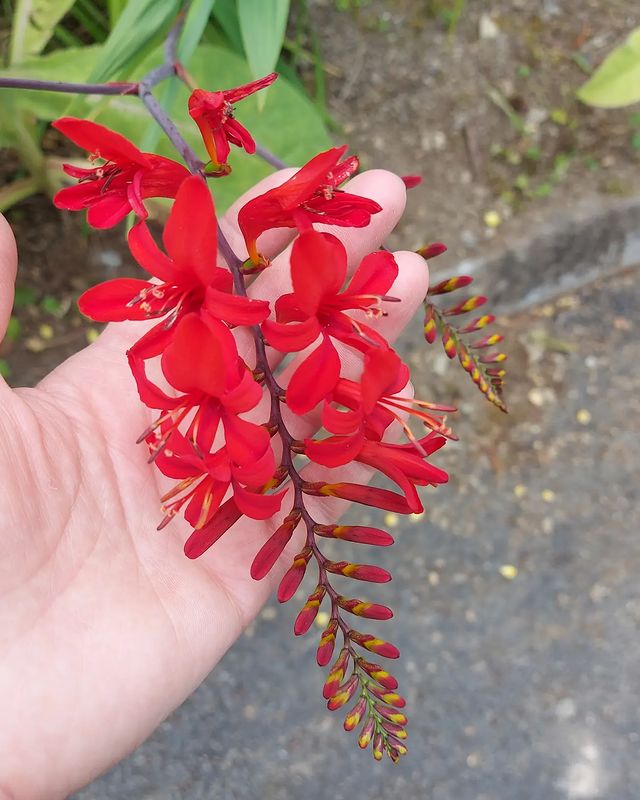Are you worried about the delay in the bloom time of your Crocosmia? Well, maintain the optimal care need, choose the suitable variety, and see the magic.
Review the article to clear any confusion about Crocosmia and how to enjoy the bloom on time.
Table of Contents Show
How Long Does Crocosmia Bulb Take To Bloom?
Crocosmia (Crocosmia aurea) falls under one of the late bloomers that complete its lifecycle in more than three years as a perennial.
Usually, Crocosmia does not bloom in the first year of the plantation because it flowers only after attaining maturity.
However, depending on the cultivar, growing conditions, and climate, it might extend to the third year.
And once Crocosmias bloom, they will flower at the same time in the following year, given their lifespan of up to 20 years.
Crocosmia Bloom Time: By Varieties And Climate
Commonly known as coppertips or montbretia, Crocosmia has a standard bloom time from mid-summer to mid-fall.

The list below gives the exact bloom time that can help you to understand the plant lifecycle and use it as cut flowers.
According To Variety
Crocosmia, with more than 400 cultivars, is famous for its trumped-shaped bloom, whose size and color vary depending on the variety.
Along with variance in color and size, the cultivars also has slightly varying bloom time.
- Crocosmia ‘Lucifer’: Lucifer is hardy in USDA zone 4 and 5 and gives blood-red, scarlet blooms in early summer.
- Crocosmia ‘Emily Mckenzie’: The Emily Mckenzie gives star-like bicolored blooms (a mix of orange and red) in late summer.
- Crocosmia ‘Bressingham Beacon’: The Bressingham Beacon also has bi-colored tubular blooms (a mix of orange and yellow) that comes out in mid-summer.
- Crocosmia ‘Citronella’: The variety has small, upright lime-yellow blooms that emerge in late summer.
According To Climate
Generally, Crocosmia is a tropical plant native to South Africa. However, hybrids produced from Crocosmia are hardy and can tolerate harsh temperatures.
They can usually grow in the USDA zone 5-9, but the bloom time can vary from zone 5 to zone 9.
- Warmer Climates: The zone having longer warmer zone can notice Crocosmia bulbs produce bloom in early summer (June).
- Cool Climates: The zone with shorter hot days and long winters can see the bloom in late summer to late fall (August to October).
However, Crocosmias typically bloom for 5 to 8 weeks regardless of the climate and variety.
Moreover, you can consult with local gardeners or nurseries on the exact bloom time based on your chosen variety.
Factors Affecting The Bloom Time Of Crocosmia
Sometimes the Crocosmia flower may not arrive according to the book rules because of specific growth factors affecting its bloom time.
The significant role players that affect the bloom time are as follows.
- Sun Exposure: Crocosmia flowers like full sun with partial shade during hot afternoons. So ensure to provide at least 6 hours of bright light to see the bloom on time.
- Soil And Drainage: Moist, well-draining soil, rich in humus and slightly acidic to neutral (6-8 pH), is fit for Crocosmia. If the soil has clayey particles, amend it with sand and peat moss.
- Watering: Keep the soil evenly moist by watering it once weekly during the active season and cease in winter. And remember to avoid water-logging conditions.
- Temperature And Humidity: Although Crocosmia has a tropical origin, it prefers mildly warm temperatures ranging from 60 to 70ºF. Meanwhile, the humidity should be drier for them to thrive.
- Fertilization: Crocosmia is not a heavy feeder. Thus, supply it with a slow-releasing fertilizer once in the spring or a 10-15-10 dose before flowering.
- Planting Date: Spring is the best time to plant the Crocosmia bulb. So any delay in plantation can push the seedling and root formation time of the plant.
From Editorial Team
Tips For The Day!
You can keep Crocosmia blooming by deadheading, encouraging the plant to give a more bushy flush.
Also, dividing the Crocosmia bulbs every 3 to 5 years after the flowering will help rejuvenate them. By doing so, you will indirectly extend the bloom time of Crocosmia.


